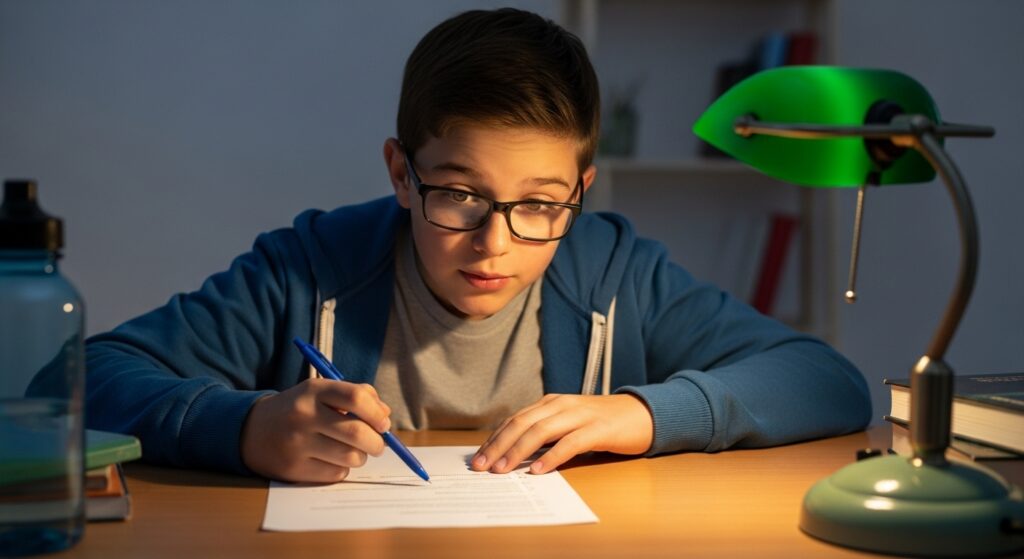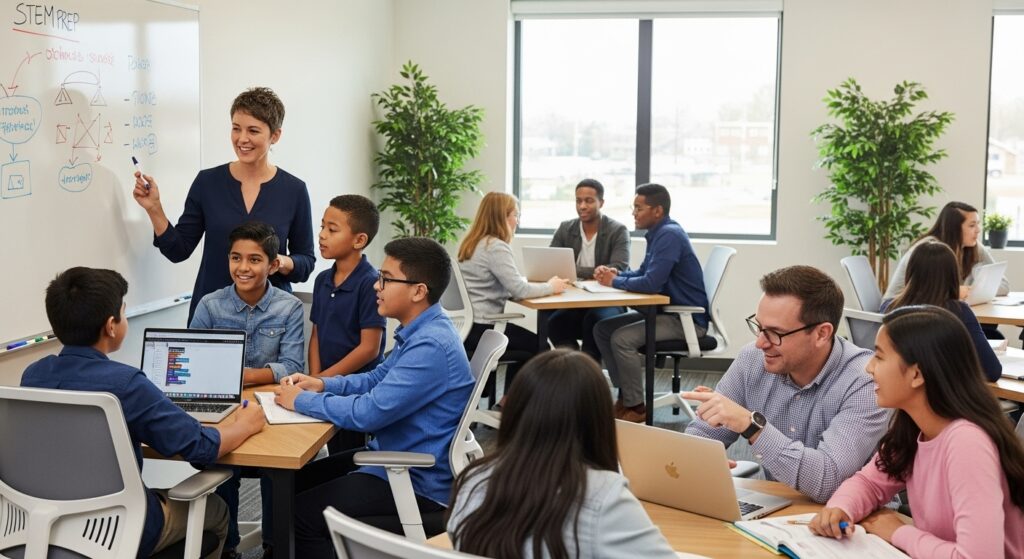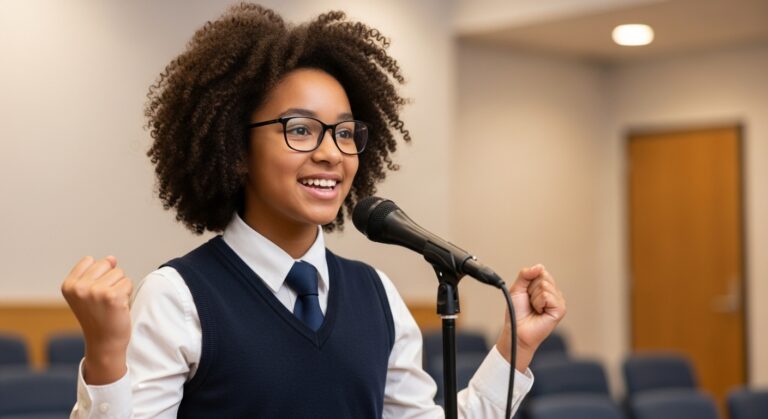The evening light always made the frustration worse. I remember those nights clearly. Sarah, a loving mom, sat at her kitchen table. Her son, Maya, was in eighth grade. Meanwhile, a nearly perfect math test lay open. Sarah felt worried. However, the grade was not the problem. Maya was a smart student. Instead, it was the obvious error that ruined the score: a simple sign change. This mistake dropped her grade from an ‘A’ to a ‘B+’. Furthermore, this kept happening. It was a pattern of persistent and frustrating careless mistakes.
“She misses the easiest things, you know?” Sarah sighed, rubbing her temples. “For example, she gets the physics ideas when we talk. Then, on the test, she forgets a unit or writes the wrong number. Consequently, she loses points for no good reason!”
I felt her pain. All parents of a K–12 student know this feeling. It is a mix of pride in their child and anger over simple errors. It feels like a hidden wall blocking success. Yet, these are not truly “silly errors.” Instead, they show that a bright student is struggling with key skills. These are called executive function skills.

The Tipping Point: How We Eliminated Those Frustrating Careless Mistakes
Sarah and I met for coffee the next day. Because this pattern of careless errors was hurting Maya’s confidence, we had to find a true fix. Specifically, Maya was starting to doubt her own intelligence. Therefore, we stopped focusing on “fixing grades.” We started focusing on changing her mindset.
“I just want to help her stop those careless mistakes,” Sarah confessed. “I need a way to make sure she slows down and checks her work.”
I told her about the major shift we see in many students. They move from a panicked approach to a calm, careful one. I explained that at STEM Prep Tutoring, we do more than teach math or ELA. We teach a system for success. In other words, we treat the “careless mistake” as a sign of a larger need, not the main problem.

Indeed, a powerful first step for any parent is to change how they approach homework help. First, stop focusing on the mistake itself. Second, focus on the steps that led to the mistake. Ultimately, this lets the student take charge of the solution. This method works well whether your child needs a dedicated math tutor for tough algebra, a reading tutor for comprehension, or PSAT 8/9 help. To learn more about our support, which includes expert tutoring chemistry and physics tutor help, visit our site: https://www.stempreptutoring.com.
6 Proven Systems to Conquer Careless Mistakes and Build Focus
I told Sarah that the secret was not a fast fix. It was a set of small, regular habits. Consequently, Maya did not need to “try harder.” She needed a plan. Specifically, we build executive function skills. This is the brain’s control center for planning and focus. This system helps all students. It works whether they need tutoring for dyslexia with a special reading and writing tutor, or they are taking hard high school STEM classes.
Therefore, here are the six strategies we shared with Sarah. We use these same methods to help our K–12 students move from ‘careless’ to ‘aware’:
1. The ‘Pre-Flight Checklist’ Ritual for Avoiding Errors
Before Maya even started her tutoring in mathematics homework, she made a short list. Specifically, this list included the common careless mistakes she knew she made. This one step makes a huge difference.

- Actionable Tip: Have your child write down 3-5 personal “Careless Catches.” For instance, for math, this could be: “Check the sign” or “Did I copy the numbers right?” Similarly, for an essay, it might be: “Did I answer the whole prompt?”
- The Science: This moves the error-checking out of their mind. Hence, they don’t have to remember everything at once. Edutopia supports teaching metacognition. This means teaching them to think about their own thinking. https://www.edutopia.org/article/what-is-metacognition
2. The Power of ‘Proof-Read-Separate’ to Catch Simple Errors
Conversely, many students just finish their work and turn it in. Instead, we teach the “Pause-and-Separate” rule. In short, they must take a break between doing the work and checking it.
- Actionable Tip: If the task is long (like a high school Science report), suggest a 10-minute break before they review it. If it’s a short assignment, they can flip the paper over, breathe, and then flip it back to start checking.
- The Logic: This creates ‘distance’ in their mind. Consequently, the brain is less likely to see what it wanted to write. It is more likely to see what is actually there. This helps avoid those frustrating careless errors.
3. Using a Different Tool for the Final Check
We encouraged Maya to change her tool when she reviewed her work. This helped break her routine and forced her brain to focus.
- Actionable Tip: Have your child use a colored pen (not their writing pen) or a pencil pointer to follow each word or number. This is particularly effective for grammar checks in ELA or checking steps in tutoring in mathematics.
- The Benefit: Furthermore, this small change makes the brain slow down. It forces a shift from “creator mode” to “editor mode.”
4. The ‘Rule of Two-Thirds’ for Time Management
Feeling rushed is a big reason for “careless mistakes.” Therefore, we teach our students smart time use. In essence, finish the work in the first two-thirds of the time (e.g., 40 minutes of a 60-minute session). Then, use the last one-third (20 minutes) only for checking.
- Actionable Tip: This rule is key for SAT or PSAT 10 (NMSQT) prep. Specifically, students learn that rushing the end is not smart. It is better to take time to check answers and fix simple careless errors.
- The Real-World Link: This is what experts do. Generally, architects spend more time checking their work than drawing the first draft.
5. Verbalizing the Process to Reduce Simple Mistakes
Students who struggle with focus often cannot check work silently. Hence, we told Maya to check her work out loud. She whispered the steps or the grammar rule to herself.

- Actionable Tip: When working with an online math tutor or a reading comprehension tutor, ask your child to explain how they got the answer before the tutor reviews it. This forces them to show their thinking. Errors become obvious right away.
- Bonus for Reading: If your child needs better comprehension, a specialized comprehension tutor or reading tutoring session can help. They can summarize a paragraph out loud before answering questions. This reduces errors a lot. Read our blog post about specialized reading support here: https://stempreptutoring.com/blog/specialized-reading-support
6. The ‘Mistake Library’ for Long-Term Growth
Ultimately, the best way to learn is by tracking careless mistakes. In essence, Maya wrote down every error in a small notebook. She labeled it: Calculation Error, Sign Error, Concept Error, etc.
- Actionable Tip: Review the ‘Mistake Library’ before starting new homework. Consequently, the student starts with a clear idea of their past struggles. This is a core part of our test prep. It stops students from repeating errors.
- Expert Insight: This tool helps students with learning differences. Understood.org offers great help on building self-awareness. That is exactly what this strategy teaches. https://www.understood.org/articles/en/executive-function-skills
The New Chapter: Building a STEM-Focused Future
As a result, Sarah started these six steps right away. She stopped watching over Maya’s shoulder and became her coach. She didn’t ask, “Why did you miss that?” Instead, she asked, “Which of yoaur six strategies will you use to check this now?”
Soon enough, Maya changed. The small, frustrating careless errors on her Science and Math tests began to vanish. Most importantly, however, she felt much better about herself. She learned that being smart meant having a system to catch mistakes, not being perfect. Learning the content was only half the fight. The other half was careful, focused work.
Because we knew the issue was not lack of knowledge but a lack of skill, our work with Sarah and Maya was a big win. The truth is, these amazing changes happen daily at STEM Prep Tutoring. We know every student can succeed. They just need the right tools. Moreover, strong study habits built in K–12 create a strong path for future STEM success.
Therefore, if your home life mirrors Sarah’s struggle, or if your child is ready to stop making “careless mistakes”, contact us. Indeed, professional support gives them the missing systems and a person to keep them accountable. You do not have to do this alone. To talk about a plan for your student’s reading tutoring, math tutoring, or specialized test prep, reach out to our team now.
In the end, Maya not only cut out her careless mistakes. She also earned a high score on her PSAT 10 (NMSQT). This opened new doors for her. Consequently, that one missed point became the start of her best academic chapter. It all started by replacing worry with a simple, step-by-step plan.

Ready to Build a System for Success?
We know every child is unique. However, the solution is always found in expert, personal help. Whether your student needs help with hard problem-solving or basic skills like reading, our expert tutors are here to help them master it.
Why not take the next step toward a future free of careless mistakes?
- Reach Out Today: Book a consultation to talk about your child’s needs. Learn how a STEM Prep Tutoring expert can make a custom success plan for them: https://www.stempreptutoring.com/contact-stemprep-tutoring/
- Stay Informed: Don’t miss out on more expert advice and proven STEM study tips. Subscribe to our newsletter for the latest strategies delivered right to your inbox.
- Comment Below: What is your child’s most common careless mistake? Share your experience and tell us which of these 6 strategies you will try first!
Further Reading: For more information on why these errors happen, you can check out the American Psychological Association (APA) resources on student learning: https://www.apa.org/topics/education/learning-styles


